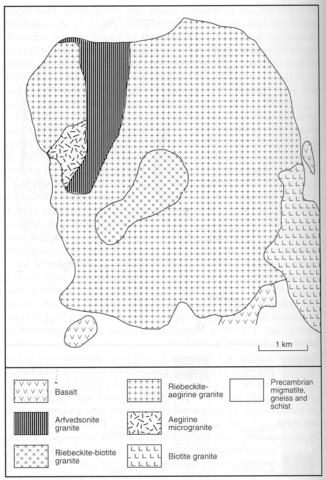stripes
Cutting Archaean basement gneisses and migmatites the Kigom complex of peralkaline granites is approximately circular and covers 356 km2 The earliest intrusion is an arfvedsonite granite that forms a roof pendant enveloped by later riebeckite-aegirine granite. It contains large perthite phenocrysts in a groundmass of quartz, feldspar, arfvedsonite, a little fayalite, pyroxene and accessories including monazite, allanite and fluorite. An elongate area of riebeckite-biotite granite in the northwest of the complex appears to pass gradationally into the surrounding riebeckite-aegirine granite with riebeckite being the dominant mafic mineral in the marginal zone, but biotite towards the centre. Buchanan (Buchanan et al., 1971) suggests that this rock was generated by metasomatism of a roof pendant of the biotite granite by the later riebeckite-aegirine granite. The riebeckite generally forms plates enclosing quartz and feldspar, and sometimes biotite; accessories in this rock include astrophyllite, monazite and pyrochlore. The most voluminous rock of Kigom is a riebeckite-aegirine granite which is highly variable with three variants distinguished by Buchanan (Buchanan et al., 1971), based mainly on whether the riebeckite is poikilitic, acicular or bladed. The feldspar is microcline perthite and aegirine is generally associated with the amphibole, both marginally and enclosed; zircon is the most plentiful accessory with a little cryolite, pyrochlore and, in a pegmatitic marginal zone, stellate clusters of astrophyllite. Galena has been found in heavy mineral concentrates and Badejoko (1988) describes and gives analyses of a Ti-rich oxide mineral which is tentatively assigned to the ferropseudo-brookite group. A small intrusion of aegirine microgranite on the western side of the complex draws the activity to a close; there is a little riebeckite present in this rock. Analyses of 18 rocks, with trace elements, including REE for some rocks, are given by Imeokparia (1984b) and discussed with particular reference to mineralization. An analysis of riebeckite is given by Borley (1963) and of aegirine by MacLeod et al. (1971) To the southeast of Kigom is the Ganawuri complex, which is linked to Kigom by a biotite granite. Although representing two centres of activity they can be considered essentially as one complex although, because the linking biotite granite cuts both centres, their relative ages are not known but they are likely to be contemporaneous. Unlike Kigom, Ganawuri is not peralkaline but consists of six phases of biotite granite, in one of which fayalite, and in another hornblende, also occur, while a seventh is hornblende-fayalite granite.
BADEJOKO, T.A. 1988. Unusual titanium-rich oxide mineral from peralkaline granite of Kigom complex, northern Nigeria. Journal of African Earth Sciences, 7: 703-6.BORLEY, G.D. 1963. Amphiboles from the Younger Granites of Nigeria. Part 1. Chemical classification. Mineralogical Magazine, 33: 358-76.BUCHANAN, M.S., MACLEOD, W.N., TURNER, D.C., BERRIDGE, N.G. and BLACK, R. 1971. The geology of the Jos Plateau. Volume 2, Younger granite complexes. Bulletin, Geological Survey of Nigeria, 32: 1-159.IMEOKPARIA, E.G. 1984b. Geochemistry of intrusive rocks associated with molybdenite mineralization (Kigom complex, northern Nigeria). Chemical Geology, 47: 261-83.MACLEOD, W.N., TURNER, D.C. and WRIGHT, E.P. 1971. The geology of the Jos Plateau. Volume 1, General geology. Bulletin, Geological Survey of Nigeria, 32: 1-110.

